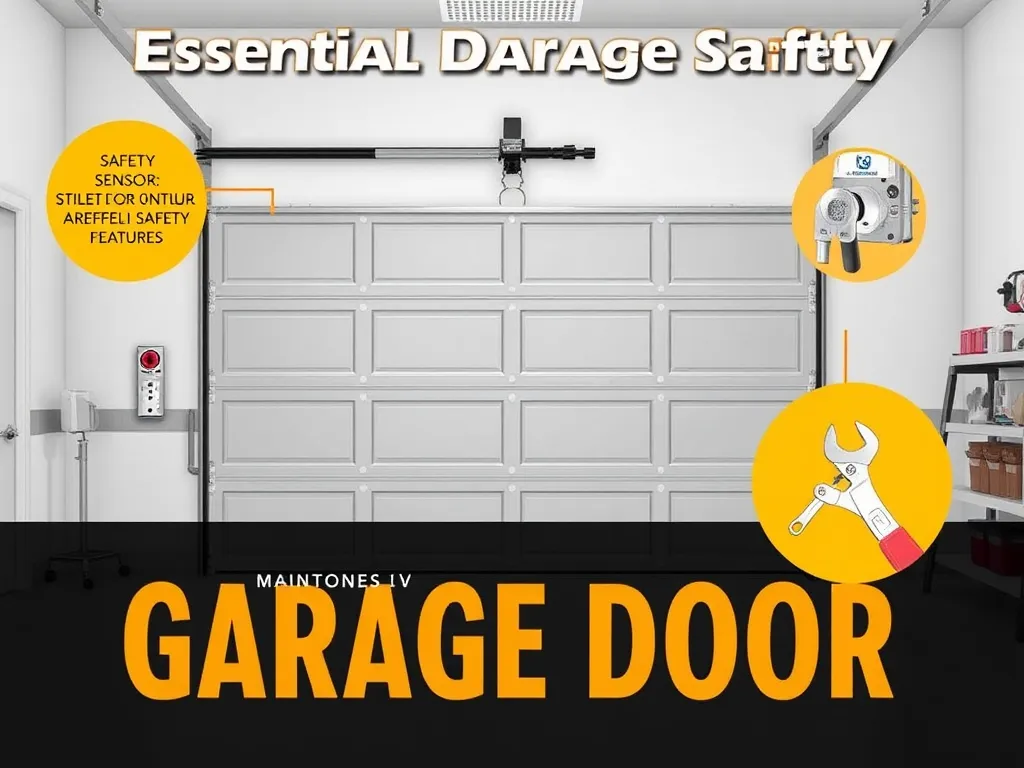Essential Garage Door Safety Measures for Every Home

Comprehensive Guide to Garage Door Safety Measures
Garage door safety measures are vital to ensuring the well-being of your family and the security of your property. A garage door is often one of the largest access points to your home and can pose a potential danger if not handled correctly. This article will outline essential garage door safety practices and the importance of regular maintenance, smart features, and careful family education.
A proper frame alignment is essential for the smooth operation of your garage door.
The importance of garage door safety measures cannot be overstated. Garage doors are heavy and can cause serious injuries if they malfunction or are not used properly. Regular maintenance and safety checks can prevent accidents, ensuring that your door operates smoothly and safely. It's crucial to understand how your garage door system works, including sensors and emergency features, to minimize risks.
Upgrading to rolling code security for your garage door adds an extra layer of protection against unauthorized access.
Additionally, child and pet safety should be a primary concern for every homeowner. Families must educate their members about the potential dangers associated with garage doors, such as pinch points and the risk of the door closing unexpectedly. By taking proactive safety precautions and incorporating modern technology, families can enjoy a safer home environment.
Implementing regular checks for garage door safety can significantly reduce the risk of accidents.
In conclusion, garage door safety measures encompass a variety of practices including regular inspections, understanding safety features, and educating household members. Implementing these measures will not only enhance your garage door's functionality but also protect your loved ones and property from accidents and intrusions.
To further reinforce safety, upgrading security measures, including installing smart opener technology and sturdy locking systems, can provide additional peace of mind. Are you ready to take your garage door safety seriously? Let's delve deeper into specific safety measures you can implement today.
When you encounter issues, Garage Door Troubleshooting can help you identify and solve problems quickly.
Regular Maintenance for Garage Doors
Routine maintenance of garage doors includes regular inspections that can identify potential issues before they escalate into serious problems. Benefits of routine inspections include ensuring that all components are functioning correctly, identifying wear and tear, and prolonging the life of your garage door. Checking the balance and alignment of the door, along with the tension in the springs, can prevent dangerous malfunctions down the line.
Lubricating your garage door is another essential maintenance step for safety. Regular lubrication of the moving parts such as rollers, hinges, and tracks can reduce friction and wear, allowing the door to operate smoothly. It's recommended to use a garage door lubricant, which is specifically designed for this purpose, to avoid damage to your door's mechanisms.
Signs that your garage door needs repair include unusual noises during operation, slow or jerky movements, or if the door is unbalanced. If you find that the door does not stay up or experiences difficulty while closing, it's imperative to seek professional assistance. Ignoring these signs can lead to severe safety issues and potentially costly repairs.
Garage Door Sensors and Safety Features
Garage door sensors are crucial components designed to enhance safety and prevent accidents. These sensors work by detecting objects in the garage door's path; if an object is detected, the door will automatically stop and reverse to avoid collision. Understanding how these sensors work is essential for ensuring they are properly maintained and functioning correctly.
Photoelectric sensors are particularly important as they detect if there is anything obstructing the door’s path. The safety beam created by these sensors will prevent the door from closing if the beam is interrupted, thereby protecting children, pets, and property. It's vital to test these sensors regularly to confirm they are operational and aligned correctly.
For older garage doors that may not have built-in safety features, it’s important to consider retrofitting them with modern safety technologies. Installing additional safety measures such as new sensors or upgrading to a garage door opener with built-in safety features can provide extra protection and peace of mind for families.
Emergency Preparedness for Garage Doors
It’s essential to know what to do if your garage door gets stuck. If the door becomes jammed or fails to open, first check for obstructions in the tracks or malfunctioning components, then try closing it manually if it's safe to do so. If it remains stuck, seek professional help to diagnose the issue rather than forcing it, which may cause further damage.
Understanding how to manually operate your garage door is crucial, especially during a power outage. Most garage doors come equipped with a manual release mechanism that allows you to disengage the door from the opener. Familiarize yourself with this process and practice it occasionally to ensure everyone in your household knows how to use it in an emergency.
Emergency release mechanisms offer an important safety feature in case of power failure or other malfunctions. These mechanisms can sometimes be accessed through a pull cord or lever, typically located on the garage door opener. Make sure all family members are aware of its location and how to use it in case of an emergency to avoid being trapped inside or outside the garage.
Child and Pet Safety Around Garage Doors
Protecting children from garage door injuries is paramount. Children should be kept at a safe distance whenever the garage door is in motion. Additionally, instruct them never to play with the garage door opener or any of its components. Teaching them about the dangers of pinching and crushing hazards will help them understand the need for caution around this heavy door.
For pet safety, owners should also take precautions when operating garage doors. Pets may not recognize the dangers associated with moving doors, and accidents can occur if they venture too close when the door is opening or closing. Training pets to avoid the garage door area while in motion is a good measure to promote safety.
It's vital to educate your family members about the potential dangers associated with garage doors. Conduct safety talks regularly and reinforce good practices, such as using the wall-mounted garage door opener button, which is out of reach for children. By fostering awareness, families can create a culture of safety around the garage door.
Upgrading Garage Door Security Measures
Installing smart garage door openers is an excellent way to enhance the security of your garage. These devices allow you to control your garage door remotely using a smartphone app. Many models come equipped with advanced features such as alerts for unusual activity or the ability to provide temporary access codes for guests, allowing for greater peace of mind.
In addition to smart systems, utilizing locks and keypads can further secure your garage door. Keypads provide a convenient way for family members to enter the garage without keys, while additional locks can deter unauthorized access. Ensure that these features are strategically placed and functioning correctly.
Choosing a secure garage door material is also crucial for safety. Opt for materials that are strong, durable, and resistant to force or intrusion. Steel and solid wood doors offer better security than lightweight options. Evaluating your garage door's structure and materials can significantly decrease the likelihood of unauthorized entry, safeguarding your home and belongings.
